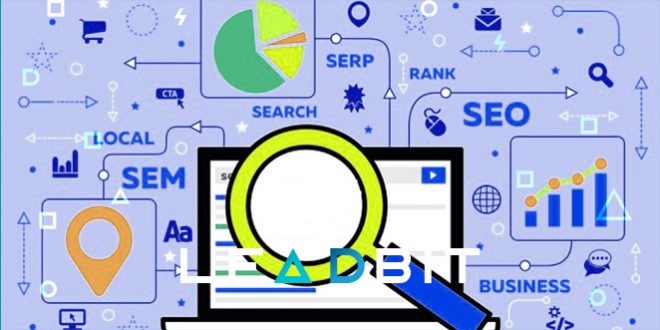Facebook algorithms are constantly evolving. This also applies to targeting (Facebook Ads Manager still has the most detailed targeting in the world, more about setting up ads in it in our guide), as well as to the study of the behavioral factor of the audience and the functionality of the resource. Algorithms for detecting spam, scams and cloaking are also constantly evolving. And the latter is a prime cause of concern for most affiliates. After all, a good half of traditional affiliate marketing verticals simply can’t be promoted on Facebook without cloaking. At the same time, Facebook partially restricts even purely white-hat cloaking.
This review is intended to clarify the situation as a whole, with part of the article being aimed at beginners to help them understand what cloaking is, why it is needed and how to use it. We will also look at the existing cloaking services and analyze other existing camouflage methods. In the course of our research, we will finally get to the bottom of the truth: is it possible to use cloaking on Facebook and how to properly do it?
Table of contents
What is cloaking

To keep our story coherent, let’s quickly go over the basics. First, let’s figure out what cloaking is in general.
The basic definition is a SEO promotion process that allows different page content to be displayed to search bots and human visitors. Today however, cloaking has gone a step further, moving far beyond SEO. Yes, at the initial stage, this was the ability to identify a bot agent by their IP address or name, and send it to a page spammed with search queries. The user will be shown quality and interesting content, just not loaded to the brink with keyword queries which made them find the page in the first place.
Nowadays cloaking means any measure that hides your online presence as such. The visitor (the target of the cloaking) can be both bots and human mods and even certain categories of regular users. There are also more ways to identify this visitor. The purpose of cloaking in affiliate marketing is different. For links – this is an improvement of user experience and an increase in the content’s visual attractiveness, for pages – the ability to show content suitable for different categories of users. For offers – this is often a way to hide offers that are prohibited on the site, disguising them as something harmless.
But this is general information about cloaking, on Facebook there are only a few methods and techniques that are actually used. Let’s talk about them in more detail.
Video on what cloaking is and why it is used
Features of cloaking on Facebook
To avoid confusion, let’s split all methods into two large groups: white-hat and gray-hat. The first group is usually absolutely harmless, aimed at improving the quality of the offer without victimizing the actual users. On the contrary, such cloaking only serves to help them. But as for the gray-hat ones, they don’t exactly harm the user, but they certainly do not bring any advantages for the website itself either. Therefore, this group is first and foremost considered to be something negative.
It’s actually quite possible to get banned both for some white-hat cloaking methods and the majority of gray-hat ones. Yes, there are a couple of gray-hat tricks that will help you avoid them. But one step at a time.
White-hat cloaking
The simplest and most popular method is affiliate link cloaking. The point is not to replace the final page where the user or bot is directed to. Not at all, it’s just a way to hide the link itself. What for? There are plenty of reasons for using cloaking on affiliate links:
- This is a way to increase the visual appeal of links. Short and easy-to-read links are more credible, users are not afraid to click on them. Obviously, a link stretching for 2-3 lines, with symbols incomprehensible to a non-tech-savvy visitor and chunks of PHP-code is not the most visually attractive component of the site. And it doesn’t really invite people to click on it;
- This is a way to improve the webmaster’s own security. There are many online scam methods, the essence of which is the theft of affiliate payouts. And the simplest and most effective method is to replace the affiliate ID in the affiliate link. Cloaking helps hide this factor, protecting the webmaster’s income;
- This is a way to automate all the work you perform with links. Cloaking helps manage a bunch of links at once, distribute them in a hierarchical structure, add, delete or modify them in bulk. Yes, when only 5-10 links are posted on the site or blog, it’s not too difficult to just work with them manually, but what if you’re dealing with 50, 500, 5000 of them?
In addition, the very essence of cloaking is to identify the subject that followed the link. In other words, you place ads on Facebook, and cloaking helps you understand who exactly clicked on it. For gray-hat cloaking, it is important to understand whether it is a bot, a moderator or a client. And as for the white-hat one, it is also important to know to which target audience group the person that followed your link belongs. With this information, you will be able to provide them with the most relevant content.
The easiest ways to do this kind of white-hat cloaking on Facebook are:
- display the page in the user’s native language. Meaning the GEO factor is identified;
- show the most suitable landing page based on the person’s age and other settings. For example, for one offer, you prepare 5 landing pages at once, each of which is aimed purely at its own target audience. The first is for younger clients, the second is for older clients, the third is for specific GEOs, and the fourth is for a particular sex. Of course, each of the groups will fall only for specific selling techniques and features. And each landing page needs to be designed individually;
- prohibiting transition to the landing page for users who have not reached a specific age. For example, if you advertise LED headlights or daytime running lights in the CIS region, and in these countries you can drive a vehicle only from the age of 18, it means that everyone who is younger is not your audience. Needless to say, some advertising is expressly prohibited by law for people under the age of maturity;
- prohibiting the transition for users using a VPN. Obviously, you don’t want a user from India who masquerades as a US resident to go to your landing. Firstly, they are not your target audience, and secondly, you pay for a premium GEO, say, $5 and get a client worth $0.1.
As you can see, white-hat cloaking genuinely helps to improve the user experience. And it does no harm, it only improves the interaction with the client, helps both the affiliate and the user. However, there are white-hat cloaking tricks that are prohibited on Facebook. For example, if you use cloaking of affiliate links and not only shorten unsightly links, but also hide the website itself, which the user comes to (Facebook), this will count as a violation. Facebook will consider this as you misleading the person, scamming them in a certain sense. To understand how cloaking affiliate links works, you can read this article.
The only thing you’ll get out of a move like that is a ban. If you display content, some parts of which contradict each other, to different target audience groups, this is also a violation. For example, the landing page informs 20-year-old clients that the promoted tool was developed especially for young people, and tells users aged 50+ that the drug is aimed exclusively at the elderly. Such inconsistencies sometimes force the affiliate to create another landing page, where bots and moderators are sent in order to hide from them the contradictions in the landing pages. This is gray-hat territory, which we are now going to talk about.
Gray-hat methods of cloaking on Facebook
On most sites (including Facebook), such methods are prohibited. We have already touched on the main reason for that – the deterioration of the user experience. But we will talk about the rest of the reasons further in the review. Now let’s quickly cover what gray-hat methods are.
This partly includes cloaking of affiliate links, as we already mentioned, it is when there is no way to track the page for the transition or the source (from where the transition was made to Facebook). But mainly when we speak about gray-hat cloaking, we mean the substitution of the transition page. This is done in the following way. The service or program that the affiliate installs automatically determines who clicks on the advertising link. If it is a bot or a Facebook moderator, then they are shown a completely clean, white-hat offer, say, a regular dating website, it is completely mainstream without any hint of prohibited content. On the contrary, a live user sees a completely different picture, explicit photos and videos, entirely adult content. The point is obvious – the user is unlikely to be persuaded by innocent ads without any teasing, while Facebook itself prohibits such adult ads. Therefore, the affiliate displays different content on the landing page.
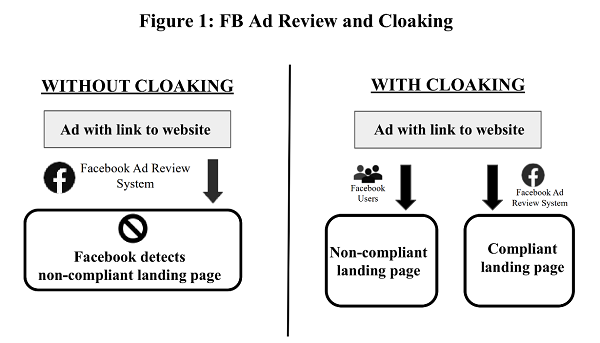
This is not yet the most dangerous method. Indeed, among the gray-hat methods there are also completely “dirty” ones, often called black-hat ones. For example, showing bots and mods a clean landing page, and users – an ordinary scamming website, the point of which is not to offer a deal but to deceive the user and steal their money. This is a violation not only of the rules of the website, but also of the legislation of most countries. Of course, this is not how affiliates work, but how outright scammers operate. Still, affiliates do not shy away from gray-hat methods. The rules of the social network prohibit promoting nutra (which often aren’t clinically proven to be effective), gambling, most sweepstakes or adult offers on Facebook. There is an enormous amount of traffic on this social network. So, there is a choice between morality and rules and serious profit, and everyone decides for themselves where they stand on that.
Facebook’s stance on cloaking
In the last couple of years, thematic news blogs are increasingly becoming full of news that Facebook has toughened its stance on gray-hat cloaking and is introducing new sanctions. Indeed, the network’s protection mechanism is evolving, old methods are no longer relevant. Cloaking services and Facebook have entered a literal technical arms race. Facebook mercilessly bans affiliates caught using gray-hat cloaking, all their funds in their accounts are frozen and there’s no way to get them back. Where does this aggression come from? Let’s take a look at why Facebook is committing such major resources to fighting cloaking.
Decrease in the resource’s credibility
Facebook is one of the most reputable social networks in the world at the moment. And if any user has at least a theoretical opportunity to go from Facebook to a resource with illegal or low-quality content, this is perceived as a blow to the entire company. This means that the security service is not doing its job, and if professionalism in one sphere is tarnished, then the professionalism of all Facebook sectors is tarnished as well. Losing credibility points, Facebook also loses stock value, which decreases Zuckerberg’s income and sends serious reverberations across the board of directors. They cannot allow that to happen.
Reduced ad demand
Up to 25% of all marketers who have refused to cooperate with Facebook, motivated their decision by the fact that they do not want to place their ads next to low-quality ones. After all, illegal content reduces the value of the entire feed, as such. The user will start always expecting a catch. Thus, cloaking on Facebook reduces the overall demand for ad space on the platform. On one hand, this is technically beneficial for affiliates, because the competition isn’t as fierce, which means that the cost per click goes down, too. But, on the other hand, a drop in demand for ad space always correlates with a drop in supply, that is, it provokes an outflow of users from the social network.
Violation of the law and Facebook rules
Rules are made to be followed, and Facebook is extremely sensitive about this. Moreover, the rules of the system are very strict, they completely fall in line with the regulations of almost any state, and do not contradict the law. Accordingly, while monitoring compliance with the rules, Facebook simultaneously checks the legitimacy of advertisers. Otherwise, in some countries, Facebook may get banned by local authorities, and then the social network will lose its multi-million audience, which again entails multi-million dollar losses.
Distrust towards ads
Cloaking is often directly related to a negative user experience. Mostly because of scammers. Yes, gray-hat cloaking doesn’t necessarily always negatively affect the attitude of visitors. Maybe by clicking on the ads, they’ll find exactly what they were looking for, even if Facebook prohibits such content. However, when following the scam links, they are bound to be disappointed. In other words, scammers hurt everyone’s interests – users, advertisers, and Facebook itself.
Blatant misinformation
Most of the examples of disinformation on Facebook are related to political topics. Especially on the eve of elections for important government posts. It is not clear whether it’s just scammers trying to cash in on traffic on the wave of election hype or whether this is the work of the candidates themselves. The fact is that users receive incorrect, unverified and sometimes deliberately falsified information.
This also goes partly for some affiliate marketing verticals. For example, saying that the product is approved by an expert source (when it most certainly isn’t) – what is this if not outright misinformation, which can also directly harm the user.
How Facebook Fights Cloaking
So, now we know why Facebook doesn’t like cloaking. But how exactly does Facebook combat it? The methods are varied. First of all, it is about improving the work of the AI. Facebook introduces more and more new and improved algorithms allowing its bots to recognize simple cloaking after the initial check. Meaning manual methods are almost entirely obsolete. Paid services are doing ok so far, because they adjust to new verification systems at the same rate as the level of AI competence grows.
However, Facebook has another method – the users. Actively collecting feedback after their visiting advertising pages, taking into account their behavior. This helps easily expose scammers based on customer complaints. Offers that are prohibited by the system, but beneficial to users, last longer.
At the same time, Rob Goldman, Facebook’s vice president responsible for advertising, said in an interview that every month new algorithms bust up to 2-3 thousand low-quality ad campaigns, followed by a ban of the business accounts they were launched from. This is a serious economic blow to those who use Facebook exclusively through cloaking.
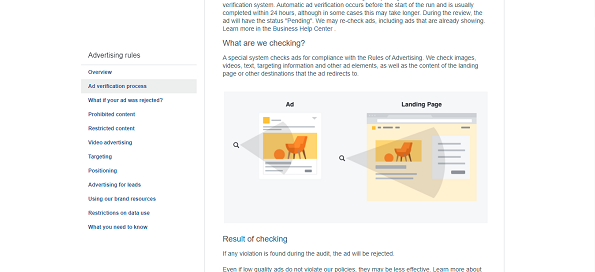
The system check is carried out in several stages. Primary – for approval and launch of an advertising campaign, with the subsequent ones occurring at any time the AI chooses. Moreover, not only is the content of the landing page checked, but also its compliance with the targeting settings, the choice of target audience. Even if you are just a beginner and you have incorrectly correlated the offer and target audience, this may already cause suspicion on the part of AI.
White-hat cloaking techniques on Facebook
Since the basic techniques of white-hat cloaking are permitted, you often won’t need to be too tech-savvy to use it. To cloak affiliate links, you can use the usual anchor link replacement, although this is a measure for beginners. It is much more logical to use one of the many plugins for your engine that can easily cope with the task on their own. What’s nice is that a significant part of them are absolutely free.
Also, if you are a little familiar with coding, you can easily hide links with a simple .htaccess trick. This does not provide guarantees against scammers stealing commissions from affiliates though. Therefore, plugins remain the best option.
At the same time, to cloak the landing pages themselves, to which the transition will be made, manual methods or plugins are definitely not enough. You will need specialized services. Even if we are talking about white-hat cloaking, it is necessary to somehow identify the visitor, which means that an extensive base of IP addresses is needed. Finding one isn’t so easy, since the services often provide it in conjunction with the main subscription.
Also, for proper cloaking, you will need to manage a bunch of landing pages at once during a single advertising campaign, and if there are several campaigns, then the number of landing pages grows exponentially.
Accordingly, both for white-hat, and even more so for gray-hat cloaking methods, it is better to use special services, a review of which we have already prepared for you.
Facebook cloaking guide
Now let’s see how the whole process looks from the technical perspective. Most affiliates do not really need this, plus, the main array of services is intuitive or is just trackers – something everything already knows how to work with. But for beginners this section will be very useful.
First, let’s define the goals. If we’re going to do white-hat targeting, just restrict traffic for some unwanted and non-targeted users, then we only need one page – the landing of the offer itself, which is usually provided along with the objective by the advertiser, or our own pre-landing, if we believe that the offer’s landing page does not fully meet the needs of the target audience.
If we are going to redirect part of the audience to other landing pages optimized for different conditions (language, selling features, technical aspects of the page depending on the user’s device, like mobile and desktop versions), we will need several pages.
And finally, if we are going to send bots and moderators to one landing page, and real users to another, we will need two pages on different domains. White page – for bots, which must be a trusted one. By that we mean that it must come from a trusted service that is a friend of Facebook. Basically, such options are sold online from $1, so you can even buy a whole pack for later, or even just quickly do it yourself using Google. Then, you need to upload the downloaded site to our hosting. In this case, the black page will be our main landing page, where all the users will be directed to. In most cases, this is an offer prohibited by Facebook’s rules. For example, adult gaming, which is currently out there breaking all records in terms of popularity.
The next step is to connect domains and links to the service. The technical side of this task is basically the same for all services, but the options and settings themselves are different. Let’s take a look at how this works using the example of the simplest service – Bhole.space.
So, the first thing you need to do is register. The process will take no more than a couple of minutes, you just need to enter your email address and verify it.
Next, we need to create our ad campaign. For this, open the left side menu and select the appropriate option.
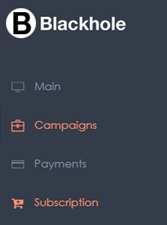
After that, we need to select a domain that we already have and attach it to the service so that it can take control of it for us.

Great, all that remains is to attach the affiliate link, as well as specify the white page and black page addresses inside it. That is, the addresses to separately send non-target and target users to. And then we configure the parameters to identify what sort of visitor clicked the link. The selection depends on the GEO, device type, browser, user characteristics transmitted by the partner, user agent, ID and more.

As you can see, the procedure is quite simple. But from a technical point of view, this service has a very narrow functionality (which is why it made its way into our list, it is an option for beginners). Broader and more expensive services provide more options, but their configuration, if not more difficult, is obviously at least longer and more dreary.
Facebook cloaking services
As is tradition, our list contains no first and last places. All the entries on our list have their own advantages and disadvantages, which we will highlight for you.
Leadcloak
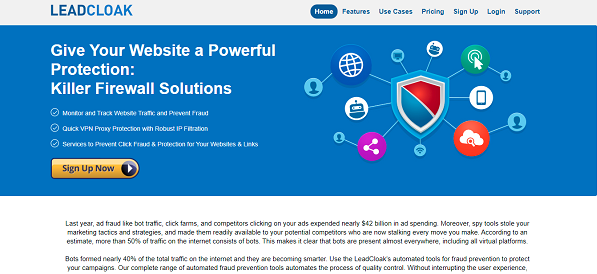
We’ll start with the cloaking service that really got Facebook in trouble. Indeed, in 2020 Facebook sued this service in the California District Court, demanding to ban the distribution of this system. To some extent, Facebook personally admitted the impotence of its own protection measures against Leadcloak. The situation is not so cut and dry though. After all, it is reliably known that many users of this resource eventually got banned. It is logical to assume that this particular service is simply the one Facebook algorithms have the most difficulty combating.
In any case, the service continues to function properly and develop. It is quite affordable, it even raised the price a little, taking advantage of the black hype that Facebook itself created with its court case. Basically though, this is an ordinary project, the main point of which is to create competent traffic filtering. It identifies not only bots, but also users with VPNs, as well as simply unwanted traffic according to the specified settings. And what you decide to do with this traffic, block it or send it to a duplicate landing page is up to you.
Advantages:
- advanced filters that allow you to sort traffic by a lot of parameters;
- live chat support for all questions, if you buy any version higher than the basic one;
- additional tracking capabilities.
Disadvantages:
- the functions themselves are rather narrow;
- you pay per click, not for a subscription. It turns out to be quite expensive for large campaigns, and it is difficult to get by with the basic version.
Price: $99 to $1,299. It all depends not on the number of ad campaigns or offers, but only on the number of clicks made that go through the filtering process. For the basic version this means 24 thousand, and for the most expensive – 1,250.
Peerclick
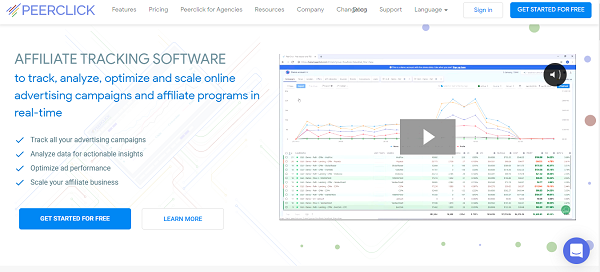
Peerclick presents itself as a professional affiliate marketing tracker. It offers competent analytics for a bunch of parameters, monitoring capabilities, and operational management of фв campaign functions. But a large number of people acquire it for other purposes. This is not explicitly stated, but the service is quite suitable for cloaking on Facebook. Moreover, on the project’s blog there is even a separate article dedicated to just these very possibilities.
Basically, it’s not that the service is outstanding in terms of cloaking, but if we also use it as a tracker, then it turns out to be a completely profitable and reasonable investment.
Advantages:
- a lot of functions;
- analytical capabilities, tracking;
- reasonable price;
- the ability to connect multiple users to one account.
Disadvantages:
- lacks its own base for cloaking;
- the cloaking settings are limited.
Price: the basic version costs only $70, has almost all the advanced features, but operates for a smaller period of time, and is also not designed for more than one user. However, for $175 or $455, you will receive all the functions of the service, and the latter includes up to 30 million displays (the service uses the CPM system). It is worth clarifying that the service also offers a completely free version, but with limited capabilities, such as limitations in analytics and only 100 thousand displays per trial.
Just cloak it
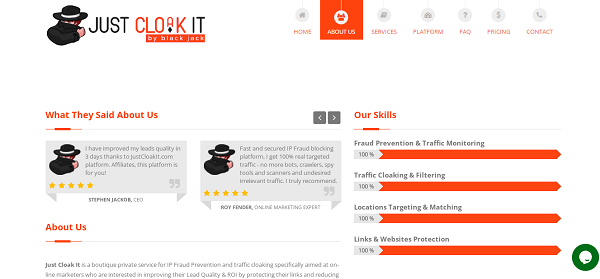
A service aimed at combating scams, bots, and unwanted traffic, protects your traffic from being monitored by your competitors, and runs incoming clicks through a lot of parameters. Obviously, the server only claims to be intended to be used against cybercriminals who are trying to squeeze out a competitor from the market by flooding them with bots (draining their entire ad budget for). But you and I both understand it can be used for Facebook just as well.
Just cloak it is convenient in that it provides comprehensive protection for all affiliate campaigns at once, regardless of the number of clicks or thousands of displays. Of course, the number of ad campaigns itself is limited by the plan. But all the same – this is an excellent choice with a large turnover, when you launch new creatives every day and you have more than one campaign at the same time.
Advantages:
- comprehensive service;
- good protection against spam;
- blocks all kinds of bots;
- blocks specific user categories according to targeting settings.
Disadvantages:
- very expensive, suitable for professionals with a good turnover;
- no version for one ad campaign.
Price: the basic version will cost you 399 euros per month, but it includes up to 5 advertising campaigns without restrictions on clicks. If you represent a large brand, then you will be interested in the “elite plan” for 1,999 euros per month, which allows you to provide up to 40 ad campaigns with any number of creatives.
Traffic Armor
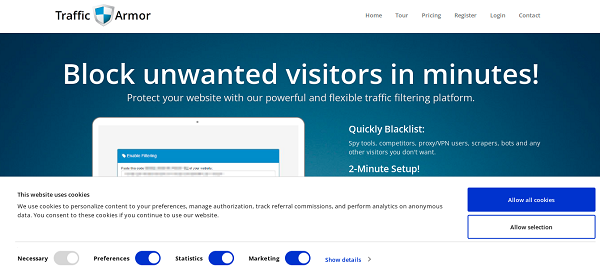
Quite an interesting service that allows you to block the traffic of your choice. In the settings of Traffic Armor you can find options to block spyware, bots and users using VPNs. You can also block users through specific targeting settings, but this feature isn’t as good here as in the three previous options.
Built-in cloaking for Facebook bots, but no IP address database – you’ll have to find or buy one. The service wants its record to be clean. At the same time, you can easily use it as an additional security measure, like a white-hat cloaking method. What is especially convenient is that it’s designed specifically for beginners. The settings are very simple, no additional technical skills are required. Meaning, if you don’t really know your way around cloaking as such, but want to give it a try, this is one of the best options.
Advantages:
- detailed settings for protection against spam and scams;
- a quick setup that even a beginner can handle without any problems;
- you can block users who do not fit your targeting parameters.
Disadvantages:
- cannot be used or gray-hat cloaking without additional modification;
- there are practically no tracking and analysis features.
Price: Basic versions cost $129 and $299, and advanced versions are $599. However, given the fact that the system is mainly aimed at novice affiliates, almost everyone chooses the former. It only includes 32 thousand clicks, but that’s more than enough for a cloaking test. And if you see a tangible increase in leads, you can always just upgrade your plan.
Cloak IT

This is one of the most popular cloaking services for Facebook at the moment. It is also noteworthy that it is designed for almost any platform. Projects often tend to focus on a specific website. But in this case, having bought one tariff, you can work with almost any social network. It is convenient if you run multiple ad campaigns across various platforms.
Cloak IT will cope quite well with common tasks, such as identifying spammers, fraudsters or users with VPNs. In addition, the service provides a fresh and fully functional database of IP addresses and Facebook bots. Moreover, it is constantly being updated. This is one of those projects that force Facebook to constantly improve its protection.
Advantages:
- a large database of bot addresses;
- usable for a variety of social networks;
- many interesting settings for blocking unwanted traffic.
Disadvantages:
- beginners will have trouble figuring out the settings;
- few opportunities for analysis, no regular tracking. However, to compensate, the service is easily integrated into most popular trackers.
Price: $100, $200 and $400 a month. Depends on your appetite and also on the number of ad campaigns and the variety of the required settings. For a single project, the initial version works just fine, so there is no point in purchasing a more expensive one unless you’re running a dozen campaigns at once. Plus, expensive versions don’t provide with more in-depth analysis or other features.
Im Klo

This service is a popular choice, especially in the CIS region. Which is why often only local affiliates work with it, but this is a mistake. The utility’s potential is very extensive; it copes with many tasks much better than its competitors.
The main feature is that Im Klo is just that – a program. Therefore, it will have to be installed directly on the server itself in order for it to start working. This means there are no paid subscriptions, you do not have to pay money every month. You just buy it once and for all. At the same time, it’s strictly illegal from the point of view of Facebook, therefore, it doesn’t have an official website as such and is distributed through Telegram.
Another important point is that the program only works with Facebook. And it has only one function – gray-hat cloaking, that is, protection from bots and mods. But it copes with this task just fine.
Advantages:
- high degree of protection against Facebook’s bots;
- its own and up-to-date base of IP addresses;
- difficult to detect, cases of people getting banned after using it are rare;
- one-time purchase.
Disadvantages:
- to manage settings even through the admin panel, you need at least basic coding skills;
- it is not used for anything else, except for gray-hat cloaking on Facebook.
Price: static – $330. Neither the number of ad campaigns, nor the time of use, nor the number of clicks affect the price. The cost for all levels is the same.
HideClick
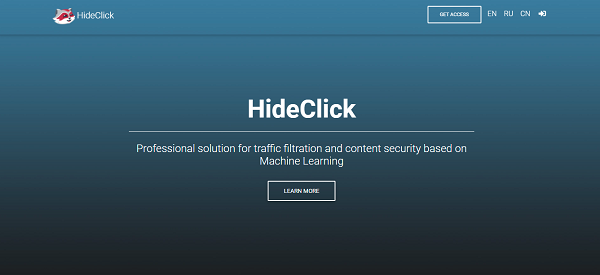
This is a professional cloaking solution. It supports any redirects, works with IPv6, easily integrates into most popular trackers. The main official function is traffic filtering. It detects bots and VPN users. It rarely works with targeting settings and does not provide any data for analytics. But, given the integration into trackers, this is not even necessary.
The level of masking is impressive, but HideClick has no IP address database. You will have to find or buy it somewhere else. At the same time, Facebook has no issue with this service, it does not ban accounts for using it. It is also noteworthy that it can be used for Google Ads as well. But not so much for other social networks.
Advantages:
- white-hat service with gray-hat features;
- easy customization;
- a relevant option that works with modern trackers;
- inexpensive compared to other entries.
Disadvantages:
- no IP address database;
- minor problems with filtering regular unwanted traffic, few targeting settings.
Price: The service has only two versions – initial and advanced. The first one costs $95, the second one – $145. A month. The trial version is also worth checking out. It provides all the functions, but only for 7 days. However, this period is quite enough for a test run. If you notice a boost in profits during this period, you can safely buy the version you prefer.
BHOLE.SPACE
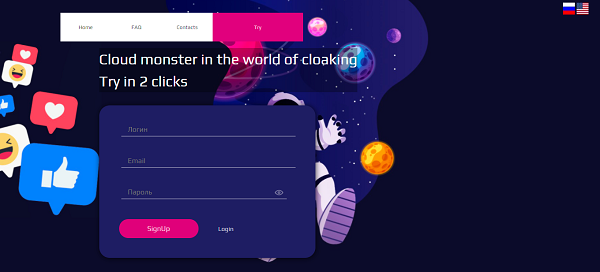
Perhaps the simplest Facebook cloaking service on our list. Allows you to filter out unwanted traffic based on the minimum number of settings. It does not have a built-in gray-hat cloaking function, and basically isn’t even used for these purposes. It protects against spam and bots, non-target traffic, all the while increasing the user’s level of data security.
The main feature is that not only a beginner in cloaking can work with BHOLE.SPACE, but a complete “dummy” even in affiliate marketing in general. All you need to do is go through the registration process, connect the domain and attach your link to the offer’s landing page or your own pre-landing. Yes, given the very narrow possibilities, the service is definitely not suitable for large-scale endeavors. But this factor is offset by the very low cost.
Advantages:
- basic cloaking functions;
- very easy to learn;
- one of the cheapest options on the market in general.
Disadvantages:
- deals with narrow tasks;
- not suitable for gray-hat cloaking;
- has no analytics and is not integrated into trackers;
- an option for beginners with only a single ad campaign.
Price: Monthly subscription will cost you a mere $25. Moreover, you can save even here by choosing not a weekly subscription. It costs $8.5. The only thing cheaper are free cloaking services.
Should you use cloaking on Facebook?
To answer this question, we will again have to divide cloaking methods into gray-hat and white-hat ones. White-hat cloaking helps (in most cases) to provide users with content that’s actually relevant to them and also protects the affiliate themselves from unwanted traffic, draining their budget on a non-target audience, bots or spam. Yes, there are also negative aspects for the social network, for example, hiding the referral address for affiliate links. But Facebook rarely bans for this. Therefore, for the most part, white-hat cloaking methods are still worth using. They will allow the diligant affiliate to simply earn more and display better ads.
However, not everything is so cut and dry when it comes to gray-hat cloaking. Yes, in most cases they will provide an opportunity to benefit from offers and verticals where it is simply impossible to turn a profit on Facebook in any other way. But at the same time, they will jeopardize the account itself along with the entire advertising campaign. After all, Facebook’s algorithms aren’t entirely useless. Thousands of accounts are banned every day, for “playing dirty”. Which means that if you decide to use gray-hat cloaking methods, keep in mind that each offer will require a new account, which in turn will inevitably get banned sooner or later. If you’re a blogger promoting a personal brand – this method yields absolutely zero benefit.
From a moral point of view, gray-hat cloaking is obviously a dishonest practice. But it’s still technically not illegal. After all, Facebook’s own rules are what gets violated, not the law (unless we’re talking about an obvious scam, the sale of prohibited products or fraud).
Conclusion
Now then, we’re done with our little study. And as it turned out, Facebook is very serious in its war against gray-hat cloaking. Which side you will take in this conflict, white-hat or gray-hat methods you will use – is entirely up to you. After all, no matter how successfully Facebook implements new methods of combating cloaking, the services that allow it to be used are also very much alive and well.

